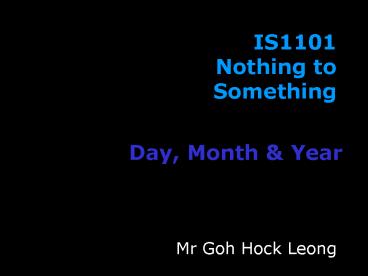IS1101 Nothing to Something PowerPoint PPT Presentation
1 / 12
Title: IS1101 Nothing to Something
1
IS1101 Nothing to Something
Day, Month Year
- Mr Goh Hock Leong
2
Content
- Tropical Year
- Solar Day
- Sidereal Day
- Sidereal Month
- Synodic Month
3
Keeping time
- Historically, the regular motion of objects in
the sky served as the basis for timekeeping. - The diurnal motion of the sky caused by the
rotation of the Earth on its axis defined the
day, - the year was defined by the motion of the Earth
on its orbit about the Sun, and - the month was defined in relation to the
revolution of the Moon about the Earth. - Although precise modern timekeeping is done
electronically, many of the details and the
terminology of timekeeping remain rooted in its
astronomical heritage.
4
Keeping time
- In using the sky for timekeeping, we must define
a reference point to determine when a cycle of
the required motion has been completed. - If we choose a reference point afixed to the
celestial sphere, the corresponding time is being
referenced to the distant stars and is termed
sidereal time. - If instead we choose the Sun as the reference
point, the corresponding time is called solar
time (or tropical time).
5
Tropical Year
- Therefore astronomers defined a mean tropical
year, that is an average over all points on the
ecliptic - 365.2422 SI days.
- Tropical years have been defined for specific
points on the ecliptic in particular the vernal
equinox year, that start and ends when the Sun is
at the vernal equinox. Its length is about
365.2424 days.
6
Sidereal vs. Synodic Month
- The sidereal month is the time the Moon takes to
complete one full revolution around the Earth
with respect to the background stars. - However, because the Earth is constantly moving
along its orbit about the Sun, the Moon must
travel slightly more than 360 to get from one
new moon to the next. - Thus, the synodic month, or lunar month, is
longer than the sidereal month. - A sidereal month lasts 27.322 days, while a
synodic month lasts 29.531 days.
7
Solar Day
- Time interval between two successive meridian
crossings (noon) of the Sun. - Exactly 24 hrs
8
Sidereal Day
- Sidereal day Time interval between two
successive meridian crossings of any star (or
vernal equinox).
9
Solar Day vs Sidereal Day
10
Solar Day vs. Sidereal Day
- The length of the solar day is variable (because
suns orbit is not perfectly circular) - Because of this, apparent solar days are shorter
in Mar and Sep and longer in Jun and Dec. - The average value of the solar day is known as a
mean solar day. - A mean solar day is 3 minutes 56 seconds longer
than a sidereal day.
11
Solar Day vs. Sidereal Day
- The stars rise and set on a Sidereal schedule.
- A star or constellation will be at precisely the
same position in the sky 4 minutes earlier with
each successive day
12
Reference
- http//www.ii.metu.edu.tr/emkodtu/met204/lectures/
section4/days.html - http//encyclopedia.thefreedictionary.com/sidereal
20day

